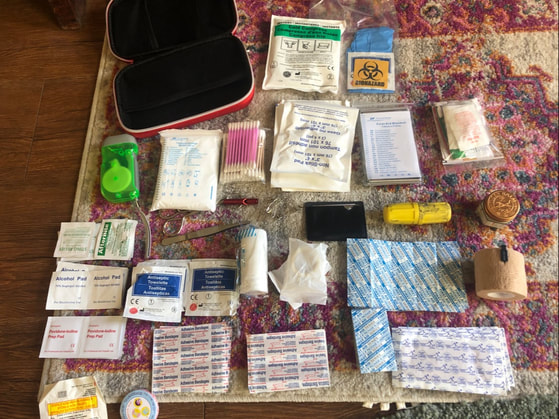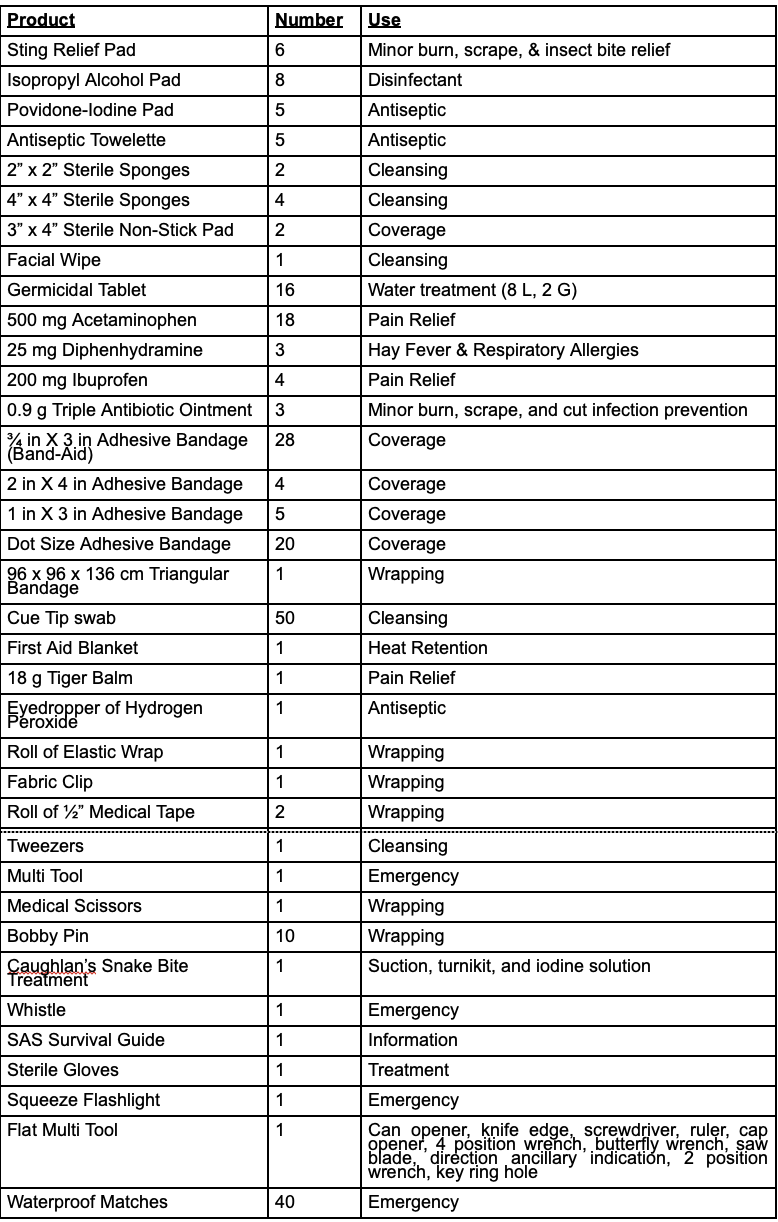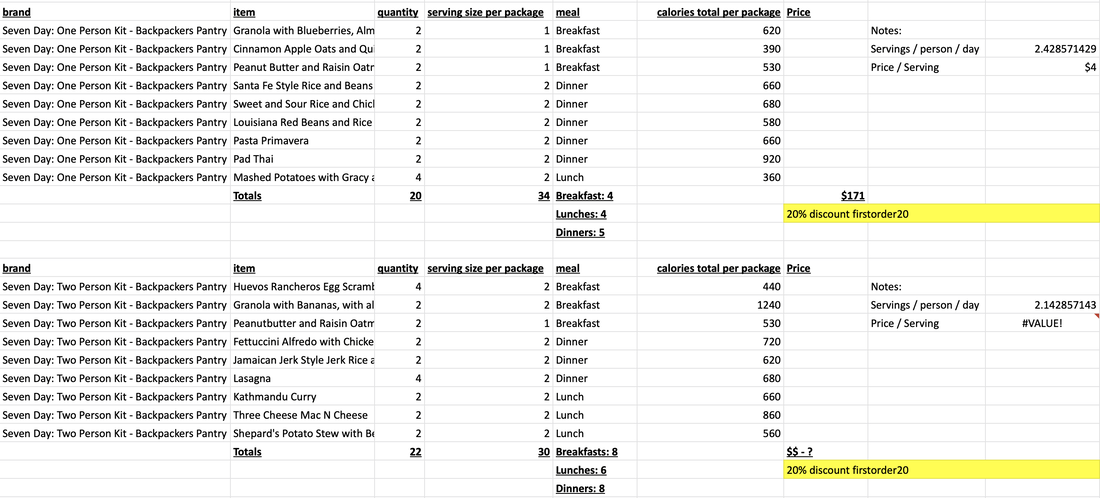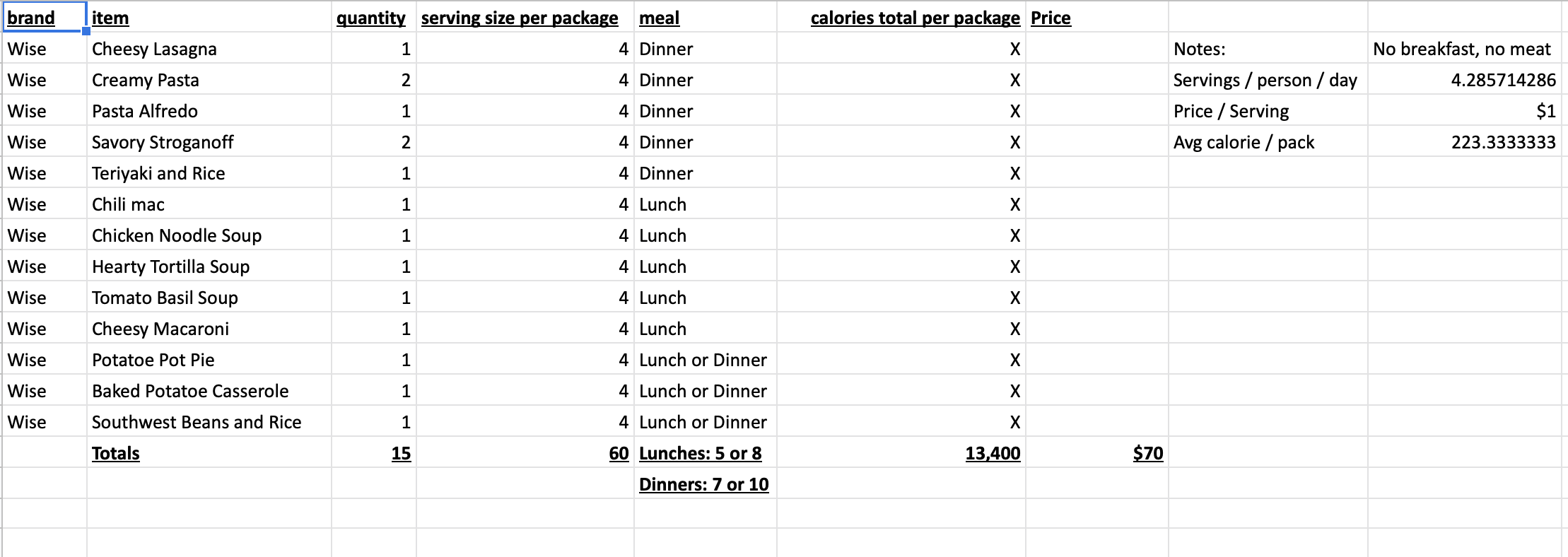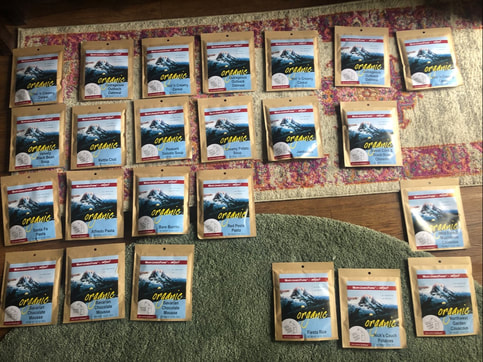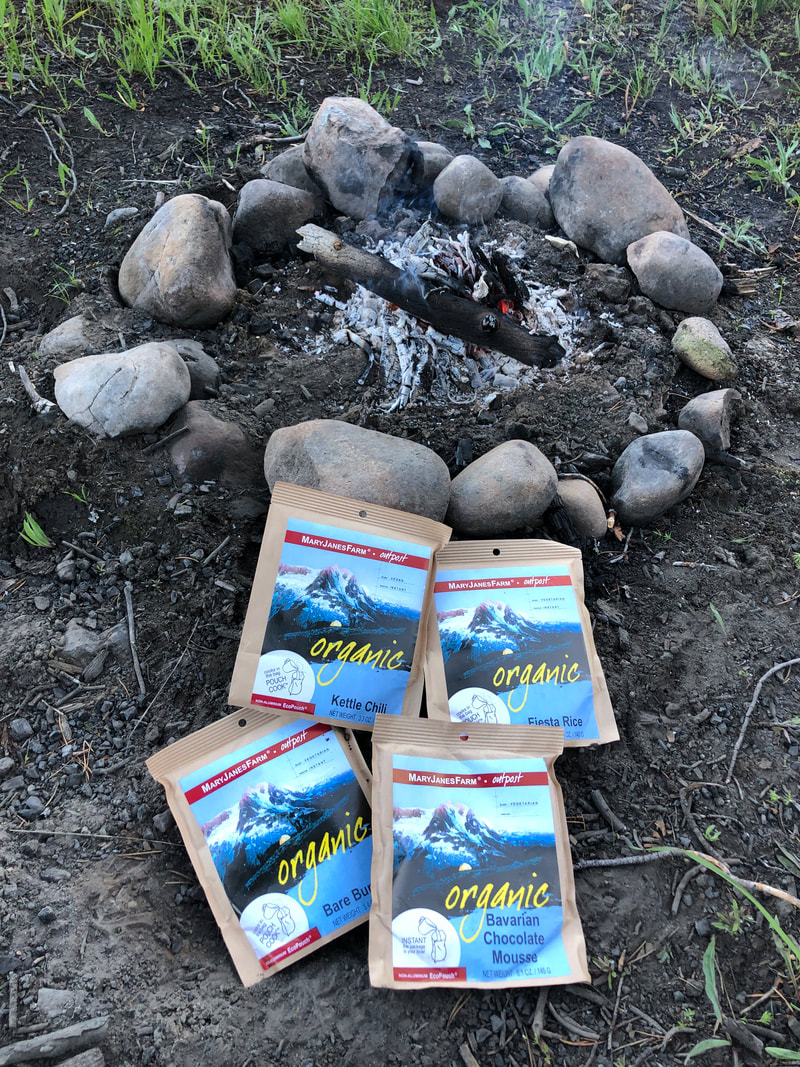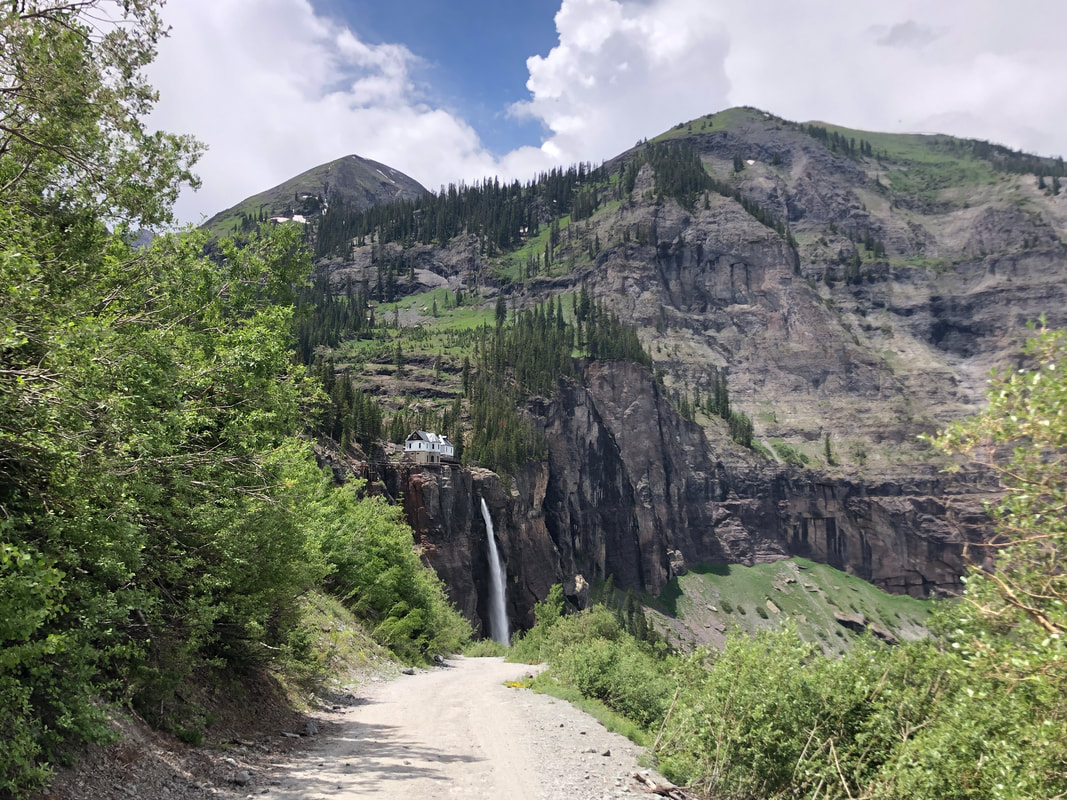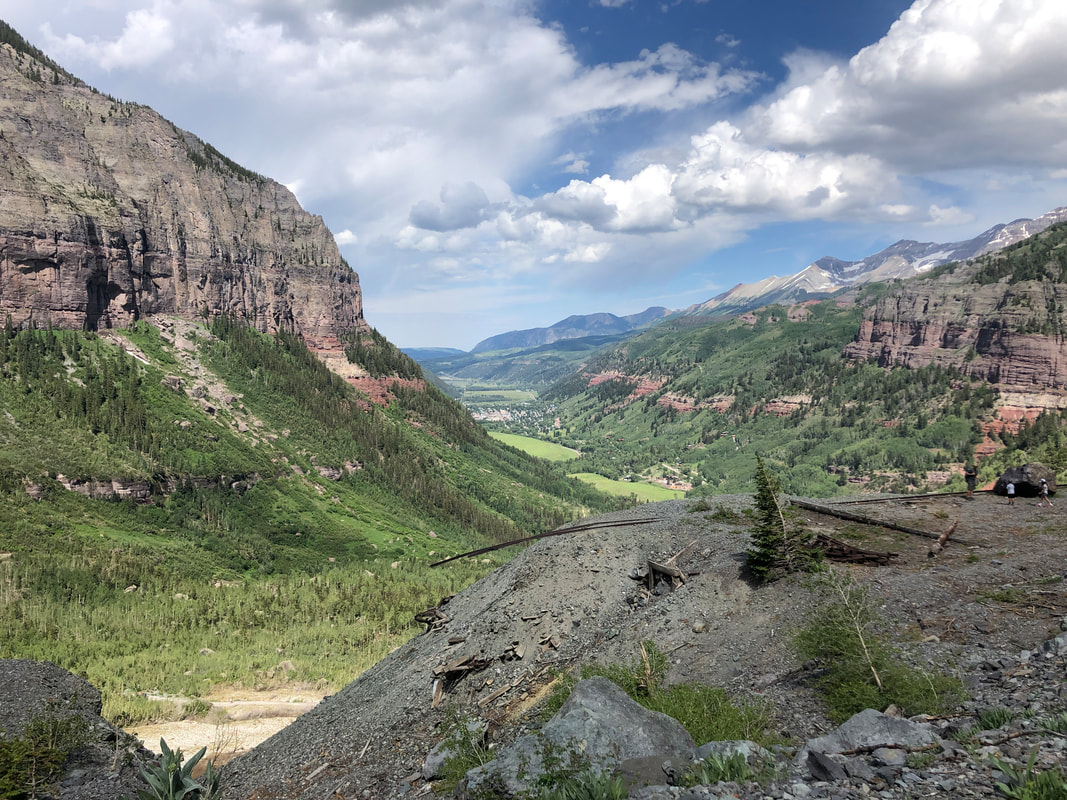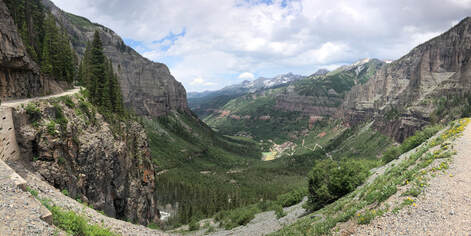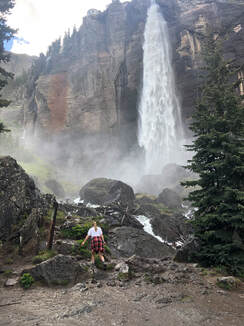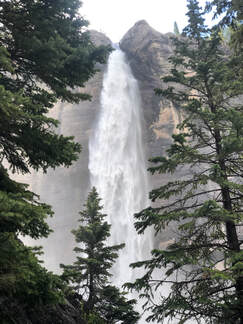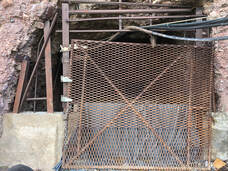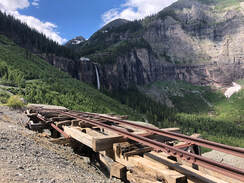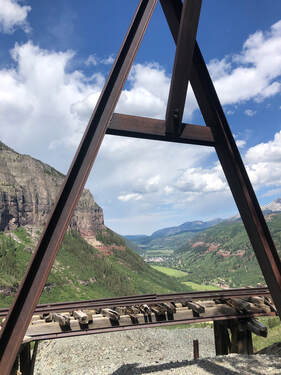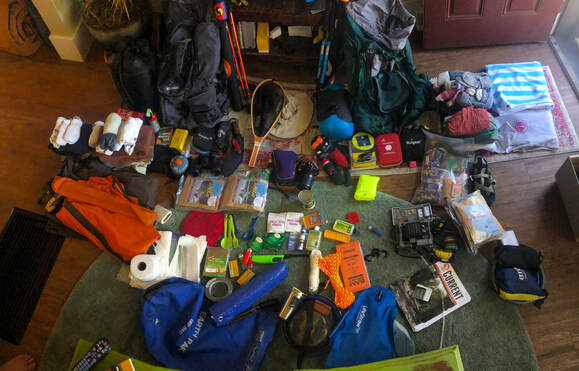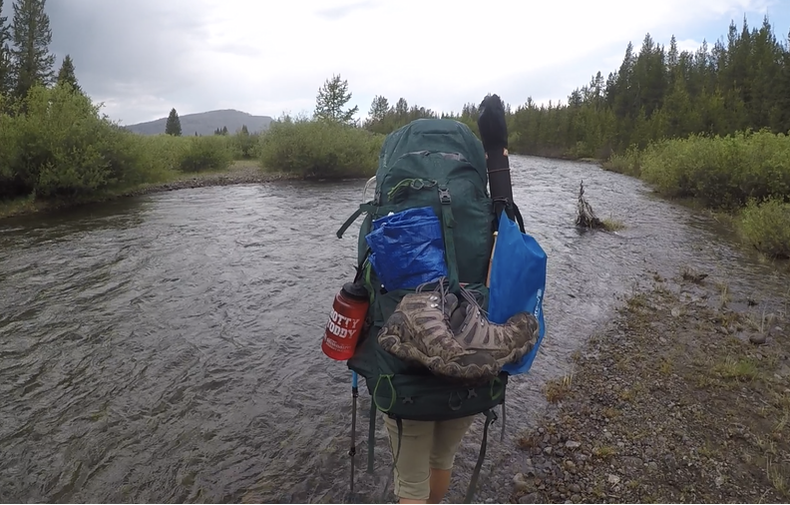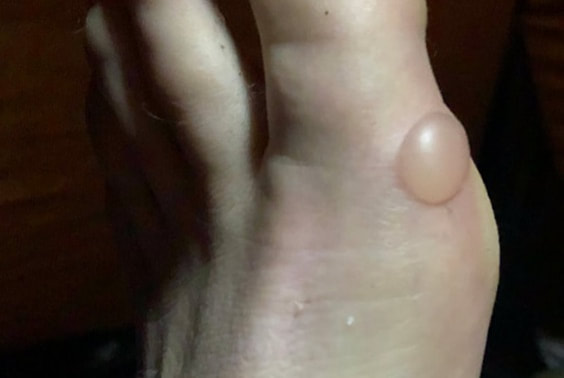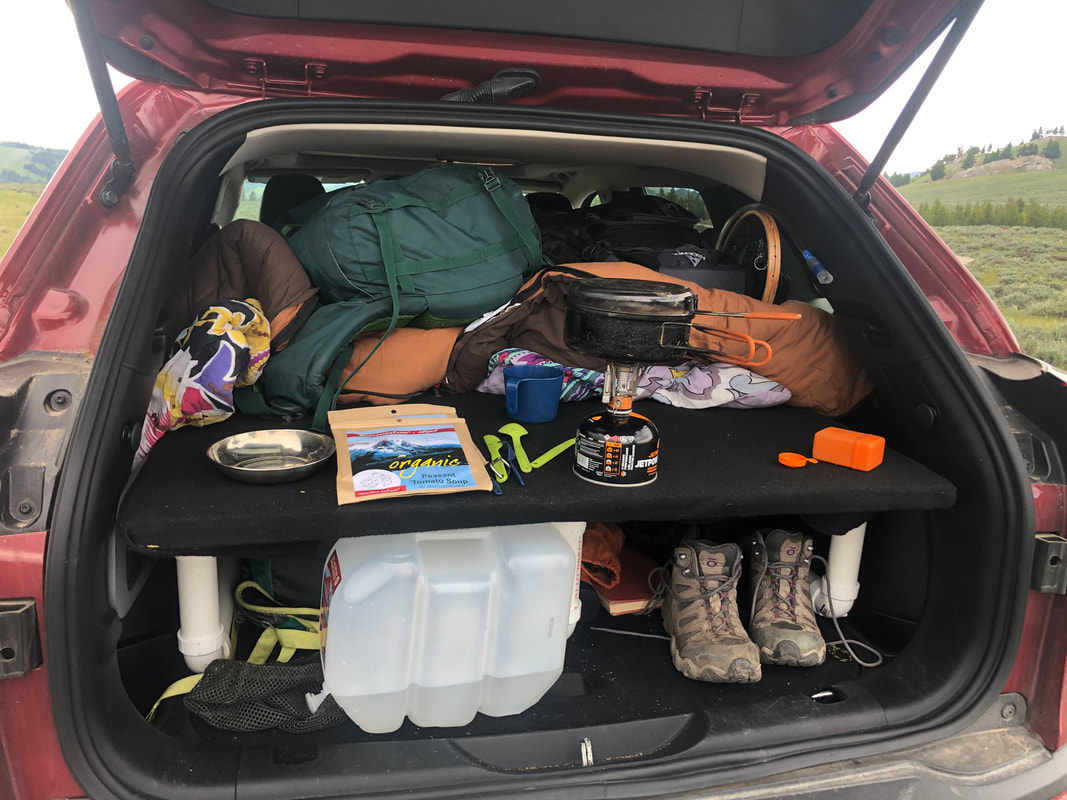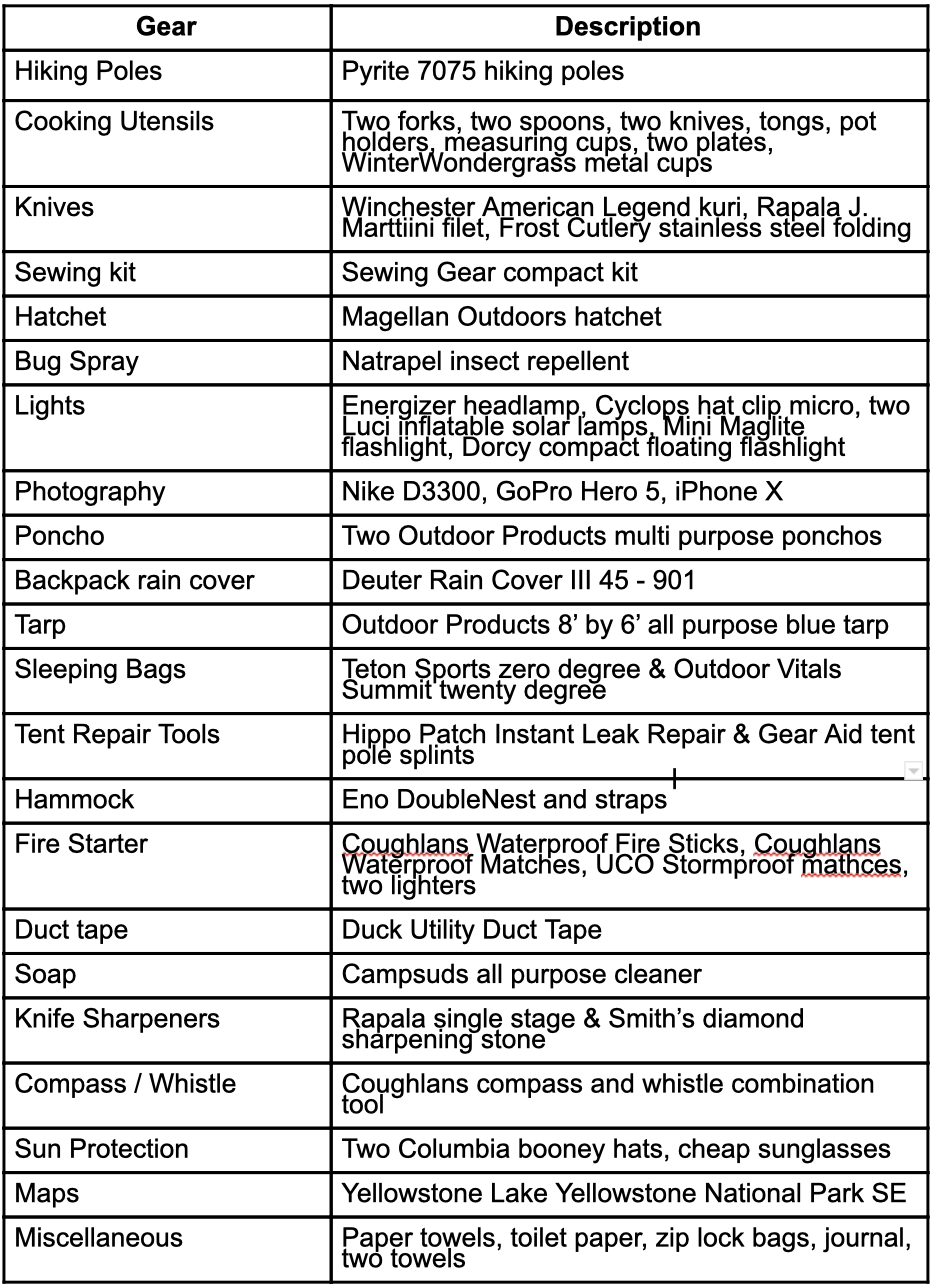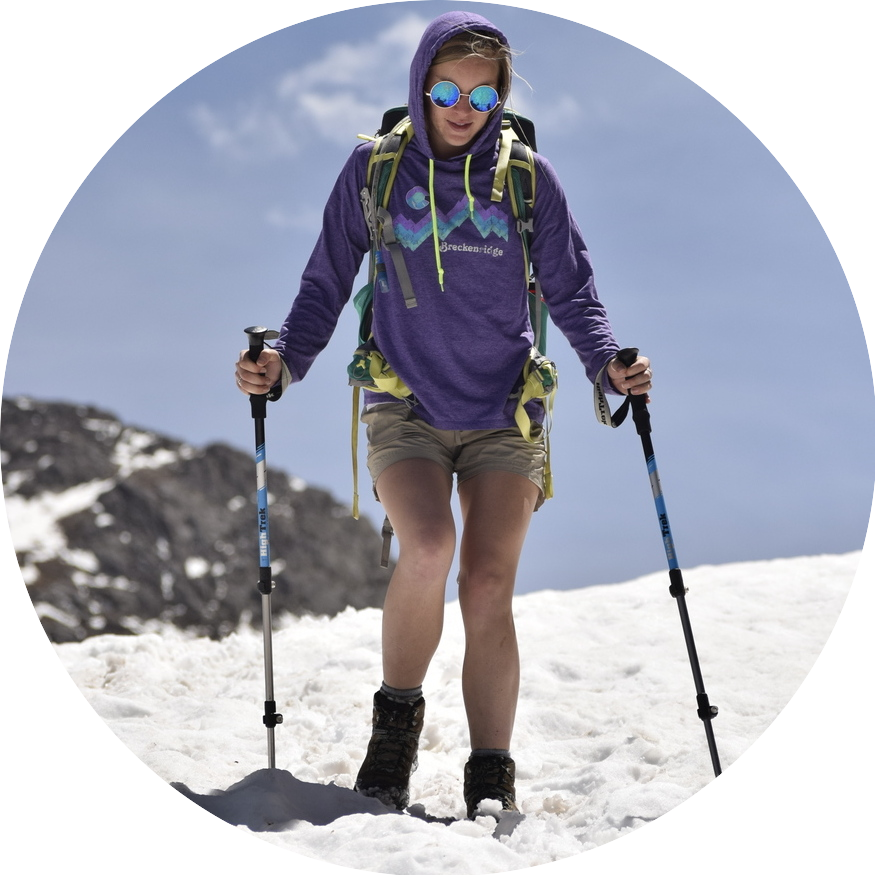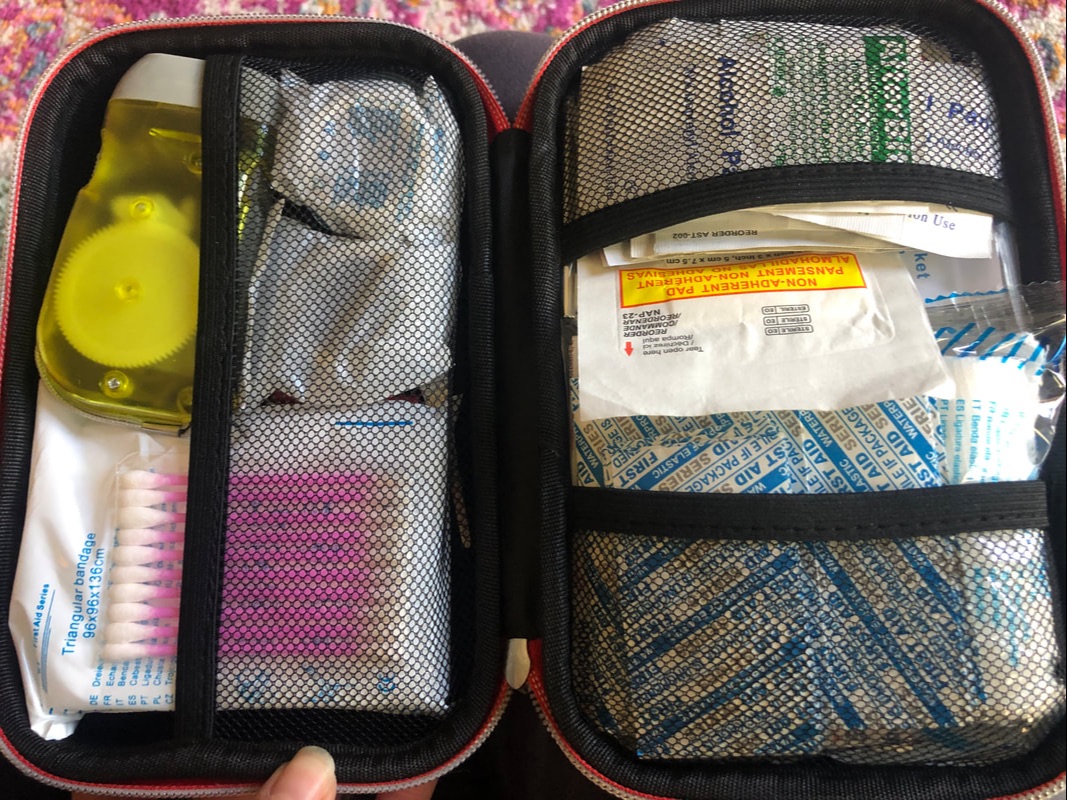 Having a complete first aid kit is critical in the backcountry. There is no way to predict what may happen in the wild, but it is possible to be prepared for common injuries. It is important to be familiar with the uses of each component of a first aid kit and know where they can be found in your kit, because quick treatment is effective treatment. Taylor and I’s trip to Yellowstone National Park was our first multi-night backpacking trip. Before we hit the trail, we did a lot of research into the different scenarios we might find ourselves dealing with in the backcountry. You can read all about our Planning and Prepping Process in this post. 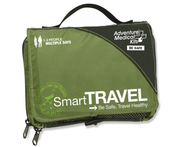 We compared several backcountry first aid kits such as Andrew Skurka’s, My Open Country’s, and The Washington Trail Association’s to other kits sold in stores like this one from REI. After taking inventory of what we already carried in our day packs, we looked at these lists and decided what was important to carry and what we needed to buy. For the most part, we were able to restock and fill our kits at our local Safeway grocery store. Anything that we weren't able to get there, we picked up at the REI in Denver. We each carried our own kits in case we were ever separated. Here is the complete list of items in each first aid kit: 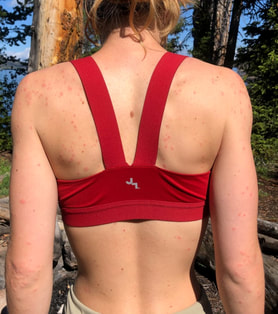 Taylor and I were well prepared with the supplies listed above. She suffered several cuts, scrapes, and bruises from being swept off her feet by a rushing creek and blisters from her new hiking boots, while I suffered a punctured palm after a careless stumble. On top of these, we were both attacked by mosquitoes leaving us covered in bites. We both used antiseptic pads for cleaning our wounds and off-brand Band-Aids to cover them up. In addition, I used elastic wrap and medical tape for securing the adhesive bandage on my palm. Taylor used moleskin to cover her blisters and insect bite relief for some of her mosquito bites. 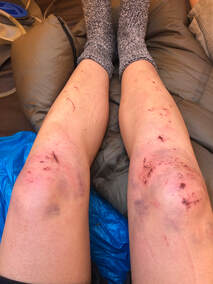 The only thing that Taylor felt we should have also carried was a cold compression pack to help relieve her bruising and swelling, but she got by just fine without it. We discovered that Taylor’s first aid kit was not waterproof even though it was advertised to be. Luckily, we weren’t in a dire situation, but some of her moleskin and bandaids needed to be dried after her slip in the water. Overall, we were well prepared for the situations we faced in the backcountry, and we hope this guide will help you prepare for any trips you might take.
2 Comments
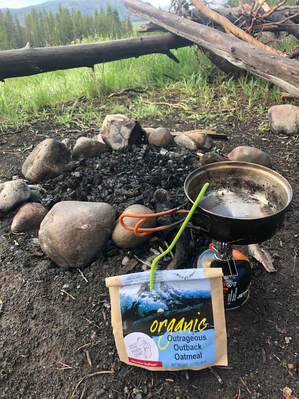 As part of our preparation for our first multi-night backpacking trip, John and I spent a lot of time researching our food options. On other trips, we had been able to keep sausage for a night or two and could carry around cans of potatoes and beans without them weighing us down. This trip to Yellowstone was much different though. We were planning for seven days in some of the most remote parts of our country, so calories, weight, and healthiness were all important factors in our choice. You can read about our entire planning and prepping process for our big trip in this post. We started our research by going into some local outdoor stores to see our options. When walking around our local REI, the first thing we noticed about meals were the cost. Upwards of $5 per meal seemed very costly. At first, the prices made us panic about our decision to try them out, but we learned about variety and bulk boxes offered when we started looking online. A quick Google search lead us to these sites that helped us start our search: Switchback Travel, Adventure Junkies, and My Open Country. Thanks to these articles, I was able to narrow our search to less than 10 brands. The companies we checked out first were Alpine Aire, Backpacker’s Pantry, Good to Go, Mary Jane’s Farm, Mountain House, Wise Company, and Wild Zora Foods. The lack of variety instantly took Wild Zora off the list. Good to Go’s variety packs were all sold out, and even though Mountain House was highly recommended and the least expensive, the sodium content was too high for us. We felt that we’d rather spend more money on healthy ingredients than carry more meals. I ended up making a spreadsheet that laid out each meal that was offered in each box I was researching. I broke down the cost, calories, and quantities of meals for Backpacker’s Pantry, Wise Company, and Mary Jane’s Farm. 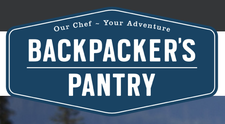 Backpacker’s Pantry had two options I was considering: their seven day one person kit and their seven day two person kit. The main issue I had with this company was their website! It would allow me to create a variety pack with the meals they had, but for some reason, they would never appear in my cart or they were just not available. I had a hard time pricing out their items because of these troubles, but from what I could tell, they were a bit more expensive than the ones we ended up with.  Wise Company offered a very large survivor style box on Amazon that cost $70 and included 15 packets. The downside is that there were there were no breakfasts, and their nutritional facts weren’t very impressive. Also, some of the comments sold it as more of an emergency preparedness box instead of camping meals, but it still came in a close second. 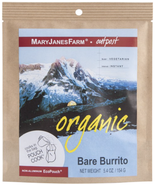 After all of our research, Mary Jane’s Farm’s “Alone At Last” was the box we chose, and we could not have been happier. In fact, we don’t really know how any dehydrated meals could be any tastier or more filling than Mary Jane’s. Every night, we were amazed by the quality of product and the consistencies of the dishes. Nothing felt gummy or uncooked. We were able to eat a meal and a soup every night, and for three nights, we had chocolate mousse for dessert! I will say that we never ate any of the meals for lunch - we each had snack bags and made tortilla roll ups with sandwich meat and cheese nearly every day for lunch. But still, at the end of the trip, we had one soup, two breakfasts, and one couscous meal left over. Overall, we were thoroughly surprised and absolutely stuffed while on the trail. We were so glad that we chose Mary Jane’s Farm for our first backpacking trip, and honestly, I can’t wait to give the others a try to really compare the taste and quality!
Check out our other posts to see what other gear we carried and the things we packed in our first aid kits!  Between shows at The Ride Festival, John and I decided to take a Saturday morning hike up to Bridal Veil Falls with the intention of making it to Blue Lake. We chose this trail because of the proximity of its trailhead to Telluride and word of mouth recommendations. 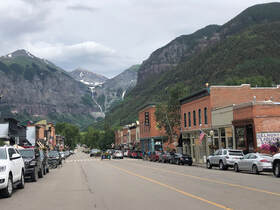 When we got to the trailhead, we were psyched to see that the trail leads up to not only Colorado’s tallest waterfall but also to the stunning Ingram Falls. Ingram Falls is visible from most of Telluride and had captured our attention since our first drive into the town. We arrived at the Valley View parking area around 9:30 am. If we had arrived any later, we might not have gotten parking spot. As we were eating breakfast and putting our boots on in the parking lot, the road filled with hikers’ and mountain bikers’ vehicles. 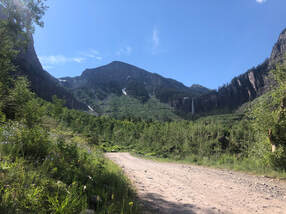 The road to the top of the falls is a steep dirt road. As the morning continued, more and more cars passed us by. They were fairly annoying, especially the ones that would shoot up dust and rocks, but we learned to face the valley and enjoy the view while they passed. The views of Telluride and the surrounding Box Canyon were unbelievable. During the entire hike, I could not stop commenting on how stunning the layered rocks were and how much better the view got as we went higher. 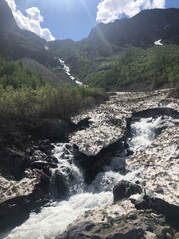 Before we made it to Bridal Veil Falls, we stopped to check out Ingram Falls at the few points where the trail crosses over or approaches its waters. This waterfall falls over one thousand feet down into the valley. Some snow atop the fall was still frozen, and it created little ice bridges where the flowing water cut through. John’s favorite part of the hike was the bottom of Bridal Veil Falls. You could feel the mist of the waterfall from a dozen yards away, and it was very refreshing after the sunny hike up. We stopped to take some pictures and helped other groups take theirs before we continued the climb to the top of the fall. 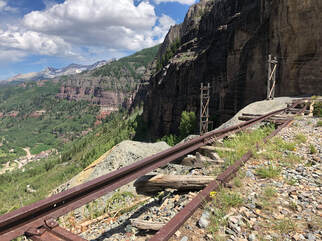 What we were not expecting to find on our way was a mine hidden inside the canyon wall. There were broken rail tracks that led straight to it. It lead our curiosity to questions like who owned it and what was the purpose of the rushing water behind the mine’s gate. A few climbers were hiking along a nearby ledge, so we followed them to a great spot where we sat and took in the view for a while. We had a snack and grabbed some water before continuing up the hill to the top of the falls. 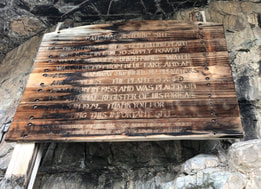 The top of the falls is home to the historic Smuggler-Union Hydroelectric Powerplant. This plant was built in 1907 and was put on the national registry of historic sites after it went out of commission in the 1950’s. Since then, it has been restored and provides power to almost a quarter of Telluride! 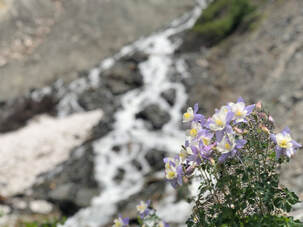 It was so incredible to see the beauty and power of Colorado’s tallest waterfall up close, and the views surrounding it made for one incredible hike. The hike is just under 5 miles round trip, and I would highly suggest it if you ever find yourself in Telluride or in the surrounding San Juan Mountains. During our weekend at The Ride Fest, we checked out Telluride’s Floradora Saloon. It offered the expected dimly lit atmosphere of a saloon but unexpectedly high prices. Taylor and I decided to give the saloon a try and were pleased with our meals.
We sat at a booth and ordered a couple of cocktails off the top. Soon after, we placed an order for the unique combination of edamame, burgers, and fries. Taylor had the ABBB burger with avocado, bacon, blackening seasoning, blue cheese, lettuce, tomatoes and spicy pickles on a potato bun. I had the Matty’s Popper Burger with bacon wrapped jalapeño poppers, chipotle aioli, lettuce, tomatoes, and spicy pickles on a potato bun. The burgers were filling and had a good taste, and it was our very first time to have edamame at a "saloon". Taylor and I should have expected to find high prices all around Telluride, but we were caught off guard by the prices at the Saloon. Aside from the taste of spending $18 on a burger, everything at the Saloon was very appetizing. Taylor and I questioned the authenticity of a saloon that sells edamame, but our time at the saloon was delightful. 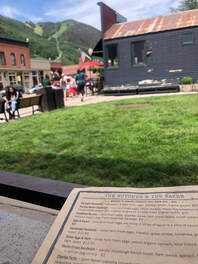 The Butcher and The Baker is a bakery and cafe on bustling Colorado avenue in Telluride. Taylor and I had a delicious breakfast while recovering from the day-before of exploring Telluride’s Bridal Veil Falls and dancing at The Ride Fest. The small shop’s doors were propped open and most of its outdoor seating faced a lush, public lawn. A glass case next to the register displays several of the bakery’s creations, but nothing looked as good as the brunch menu’s descriptions.  Taylor had gluten-free blueberry pancakes and a cappuccino, and she added whipped cream to both. I ordered the Day Maker sandwich full of two eggs, white cheddar, breakfast sausage, house-made pepper jam, and arugula on an English muffin. It paired perfectly with a hot drip coffee. Both orders were enjoyed al fresca in Telluride’s beautiful July weather. Our best meal in Telluride was compliments of the Butcher and Baker. The atmosphere was welcoming, and the food was mouthwatering. It’ll be tempting to revisit the next time we’re in Telluride. 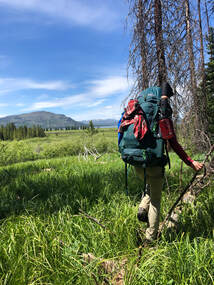 When Taylor and I determined that we’d spend 2019’s Fourth of July backpacking in Yellowstone National Park, we knew that several pieces of critical gear would ensure a successful trip. Before we started packing though, we had to find a trail and determine its safety. We spent a great deal of time researching and preparing for our trip, you can read all about it here! Once we were ready to pack, we took even more time determining what gear was important and getting it all packed in our two packs. This post lays out the gear that Taylor and I felt was the most important, why we picked it, and whether or not it performed as well as we had hoped.
The packs that so trustily carried our remaining gear were the Ascend MS 4400 and Kelty Coyote 80. This was Taylor's first time carrying her pack and my Ascend has seen pretty good use over the three years I have had it. 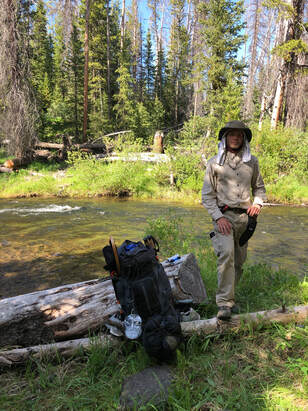 My bag has been stuffed to the brink of its capacity more than a few times. All of that use has lead to two non-major faults: The sternum strap detached from the shoulder straps and a five inch rip has opened up along the pack’s primary compartment seam. It's nothing too major, but I need to find some way to patch it soon. Taylor’s Coyote 80 is a bit big for her, she again purchased this from REI’s sale section and she picked up a men’s pack. This causes it to sit about 2-3 inches too low on her hips, but it does carry more gear than my Ascend. The weight of Taylor's bag almost caused a costly mistake later on in our trip. We learned a lot about carrying the correct weight and packing our bags properly. We wrote a "10 Things We Learned In the Backcountry" post, you can read it here to see what other useful knowledge we gained on our first trip. 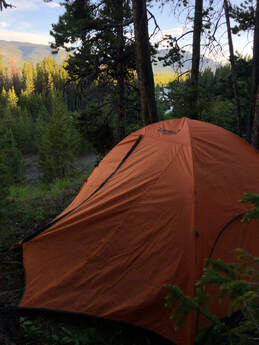 The most important piece of gear inside our packs, aside from first aid - which we listed out in this separate blog post, was our tent. Taylor and I have had our Eureka Apex 2XT (2015 version) tent for almost 3 years now and it has been the most impressive piece of gear we’ve used on the trail.. We’ve used this hardy tent more than 30 times and have never had to deal with a tear, leak, or broken tent pole. The rain cover did a perfect job protecting us in Yellowstone’s backcountry and helps keep the heat in when the temperature drops. 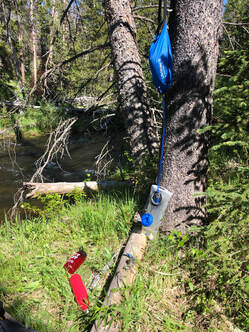 Long days of hiking require plenty of drinking water, and water filtration is critical for mitigating the risks of drinking from flowing streams. Taylor and I purchased the LifeStraw Flex with gravity bag system before our trip into the backcountry, and we could not have been happier with its performance. The system filters up to one gallon at a time at a rate of roughly one liter per minute. We were nearly able to fill our respective 32 ounce Nalgene and RTIC water bottles and each of our two liter water bladders with one gravity bag full of water. The LifeStraw water filtration system is effective and leaves spring water tasting as delicious as it should. 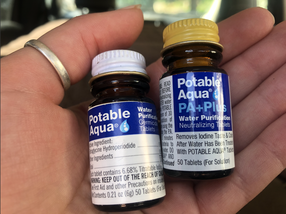 When we didn’t want to stop to filter water, Taylor and I treated collected water with Potable Aqua iodine germicidal tablets. These tablets take 35 minutes to cleanse water of harmful agents and require careful proportioning. Taylor often passed her treated water off to me due to the unpleasant taste, and we have since decided that iodine tablets are best kept for emergency use. 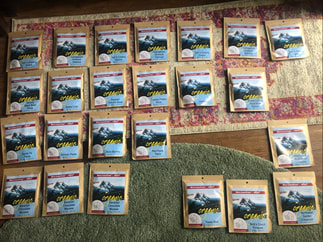 Along with our filtered or treated water, Taylor and I carried and cooked dehydrated meals for the first time. We compared several different options and were very deliberate in our choosing Mary Jane’s Farm thanks to their low sodium content and variety options offered. Were thoroughly happy with our choice and were full every night. You can read about our decision process in this post! 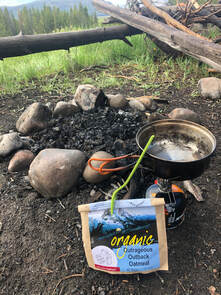 There were some days where we would not have been able to boil water for these meals if it hadn’t been for our MSR PocketRocket and our Jetboil Jetpower 8.11 ounce fuel canisters. They have been lifesavers over the years when campfires are banned or weather conditions prevent them. We also used it when we were driving around the park and car camping outside the park every night. It really helped make the dehydrated meals even more convenient. 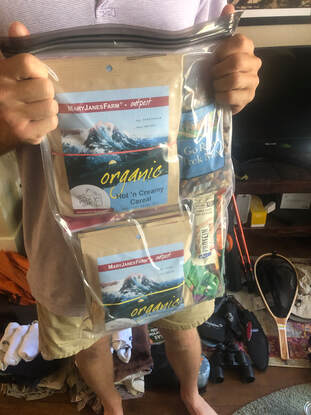 Carrying food into Yellowstone’s backcountry requires careful storage to keep from attracting bears. Taylor and I purchased four Loksac Opsac scent locking 12” by 20” bags to keep our food and other scented items. We placed those filled bags in a 20 liter Earth Pak dry bag before using 100 feet of rope and carribbeaners to hang the bags out of reach. Bears can also be encountered by chance on the trail. Taylor and I each carried large knives and 8.1 ounce cans of Counter Assault Bear Deterrent. The powerful pepper spray can reach a distance of 32 feet, and it gave us peace of mind as we ventured into bear country. Though these were the critical pieces of gear that made our time in the backcountry safe and reasonably comfortable, we had much more on our backs each day. Here is a complete list of the rest of the gear we carried on our journey. Just outside of Yellowstone National Park, restaurants and gift shops define West Yellowstone, Montana. Old Town Cafe is among those serving breakfast, and their plates of morning grub stuffed Taylor and I after we’d camped nearby in Idaho. You can read and see about where we slept outside of the park in this post here!
Old Town Cafe features a diner, a barroom, and a video lottery room. The diner is a brightly lit, beautiful wooden room with a bar and visible kitchen. Sitting underneath one of several paintings of cowboys, trains, and bears, Taylor and I ordered a delicious breakfast. I had hot cakes, sausage, hash browns, OJ, and coffee. I couldn’t have asked for a better tasting or more filling meal. Taylor nearly finished all of her six ounce sirloin, eggs, sourdough toast, and OJ. We both agreed, then and there, that the breakfast was just what we needed before a long day of exploring Yellowstone's wonders. 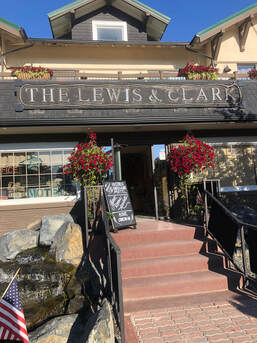 Three Forks, Montana, is 31 miles from Bozeman and home to The Lewis and Clark Motel. Originally the Milwaukee Railroad and Puget Sound Railroad Clubhouse, this quaint hotel is where Taylor and I stayed between days in Yellowstone National Park. Most other nights we camped, or slept in my car camper, but after several days backpacking through the backcountry we decided to splurge on good rest and showers. Since it was the Fourth of July, available rooms were few and far between near the national park, but a second floor room with a single queen bed was available 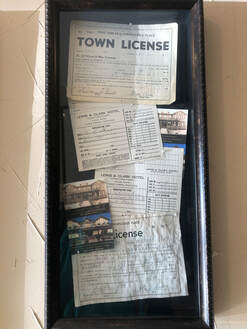 The cozy lobby and welcoming receptionist were the first signs that we’d made a good choice for the night, but the balcony and bathroom heat lamp amenities sealed the deal. We both slept comfortably and woke rested. Complimentary coffee and banana bread was icing on the proverbial cake. Though it was a long way from Yellowstone, the Lewis and Clark Motel of Three Forks was a luxury that Taylor and I couldn’t have been more thankful for. 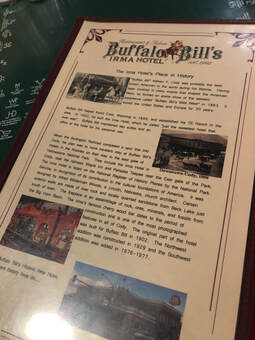 Buffalo Bill’s Irma Hotel and Restaurant in Cody, Wyoming, is a city staple and is listed on the National Register of Historic Places for its "contribution to the cultural foundations of America". Taylor and I stopped in for a burger after five days of backpacking through Yellowstone National Park’s Backcountry. Taylor and I arrived in Cody looking for a hot meal, and the Irma’s kitchen was still open late on the Fourth of July, plus the building’s rooftop railing and large sign distinguish it among its Sheridan avenue neighbors, so we walked in.  We had no idea that we were walking into a historic building. Taxidermied big game filled the walls of the downstairs restaurant and bar, and a gorgeous cherry bar gifted by Queen Victoria of England sat as a greeter when you walked in the front door. Since its opening in 1902, the establishment has since been foreclosed, sold, expanded, and reopened, but it still holds it old western sentiments.  The dining area was full of patron’s and the prime rib buffet seemed to be a popular choice. Taylor enjoyed a Buffalo Burger while I had the Irma Philly. Both of our plates were cleaned, and we were both satisfied. The decorations and artwork inspired conversation, and the staff was busy but effective. If Buffalo Bill’s Irma Hotel is on par with the restaurant, this landmark will be around for a long time to come. Stuffed Crepes and Waffles served Taylor and I a delicious breakfast before we continues our driving exploration of Yellowstone National Park. Located on Main Street in Bozeman, Montana, near the corner of South Willson Street, this counter-service restaurant serves many savory and sweet creations.
I fawned over my ‘Georgia’ waffle with caramelized peaches, cinnamon, sugar, walnuts, bequet caramel sauce, and homemade whipped cream. Taylor substituted ham to her ‘Vermont’ crepe before devouring it. It usually consists of bacon, cracked egg, diced tomatoes, and sharp white cheddar. We both enjoyed a cup of Coldsmoke coffee and warm rays of sunshine while sitting at a streetside table. From time to time, Taylor and I discover delicious and hearty breakfasts while on the road. Bozeman’s Stuffed Crepes and Waffles is one of those fantastic locations. Tasty would be a tragic understatement, and I would go back for breakfast without hesitation. After an extremely incredible and eventful backpacking trip in Yellowstone National Park’s Backcountry, John and I took three days to drive around the park and see all the highlights. You can read and see all about it here!
After our first day in the car, we drove through Pray, Montana, on the way to the Lewis and Clark Motel in Three Forks, Montana. The Emigrant Outpost was the only place serving food at 9pm and we couldn’t have been more thankful. Though they were only serving fried food, we were able to order two dozen buffalo wings and fries. A cold beer each complemented our meal while a crowd of locals laughed and drank at the bar. Emigrant Outpost was a life-saver for John and I. We were starving and couldn’t have been more happy sitting in front of a hot meal. It is one of the only places serving food in Pray late night, and it seemed to be the home base for a certain group of Montana natives. We weren’t in on the party, but we did get enough food to fill our bellies for the night. |
Talkin' 'bout Tacos:
I'm Taylor, aka Tacos! I am sharing my journeys and experiences from across the world, hoping to inspire travel and adventure in all who read! Archives
July 2024
|
